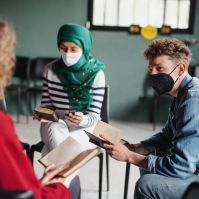 Richmond is home to several historic churches, many of which have their heritage in the Anglican church. Virginia was an English colony before the Revolutionary War. When the Declaration of Independence was signed, the Americans were considered traitors of England.
Richmond is home to several historic churches, many of which have their heritage in the Anglican church. Virginia was an English colony before the Revolutionary War. When the Declaration of Independence was signed, the Americans were considered traitors of England.
Although clergy in the Anglican Church in the newly formed US tried to maintain ties with England, parishes were devastated. England withdrew financial support from the American churches. Many clergy fled, unsure of their loyalties to the new country or the home church. During the war, churches were destroyed.
Richmond took a big hit during the American Revolution, then again during the Civil War. Considering the history of the city, it’s amazing that anything was left to remember important events and history.
Polegreen Church
This historic church stands out as the one where Rev. Samuel Davies pastored. Davies was the first non-Anglican licensed to preach in Virginia. Patrick Henry probably learned his oratory skills from Davies. The original church building was destroyed in the Civil War. Today, a white silhouette structure sits on the site and represents a historical interpretation of the building. This year, it’s celebrating 275 years of history.
Congregation Beth Ahabah
It’s estimated that Jews settled in the Virginia Territory as early as the mid-17th century. Richmond has one of the oldest Jewish congregations in the United States. The first synagogue was built in 1822, but the present building being used by the congregation was dedicated in 1904. The same architects who designed the St. James’ Church were responsible for the synagogue. It’s thought that Monticello, Thomas Jefferson’s home, influenced the design of the synagogue.
The synagogue has stunning stained-glass windows around the sanctuary. Look for the window that depicts Mount Sinai. It was created and signed by Louis Comfort Tiffany. There are 29 beautiful windows that each tell a story.
St. John’s United Church of Christ
Don’t confuse this church with St. John’s Episcopal Church. This congregation formed in 1843 to serve German Lutherans in Richmond, but it never formally identified with the Lutheran Church. The present building was constructed in 1928. The church houses one of the three remaining intact EM Skinner pipe organs on the East Coast. Its German heritage is still remembered today with an annual German dinner.
Manchester Slave Trail
Although this site isn’t religious in nature, it’s a memorial to the lives of the past. Richmond was a main port of entry for slaves. This is one of the trails they walked to get into the city. The Richmond City Council Slave Trail Commission’s mission is “to recognize the regrettable time in our nation’s history when parts of the United States allowed the enslavement of fellow human beings.” There are actually 17 markers throughout the city that present the history of slavery.
Museum of Virginia Catholic History
This museum traces the history of the Catholic Church in Richmond. It just opened in 2003, but the Diocese of Richmond was established in 1820. The collections are housed in the Cathedral of the Sacred Heart, the mother church in the Diocese. The Cathedral is a Virginia Historic Landmark itself. The architecture is Italian Renaissance Revival style. Make sure to notice the copper dome and Corinthian columns.
Sixth Mount Zion Baptist Church
Rev. John Jasper founded this church in 1867. Jasper was born into slavery and converted to Christianity in 1839, at the age of 27. To follow in his father’s footsteps as a Baptist minister, Jasper had to convince another slave to teach him to read and write. During the war, he ministered to Confederate troops. When the Civil War was over, Jasper was emancipated. The church was organized in an abandoned horse stable. It would become a religious and social center in Jackson Ward. In just 20 years, the church had 2,500 members. Mount Zion has addressed the social concerns of the black community since its organization. Today, it continues its tradition in helping families overcome economic, social and personal obstacles.



